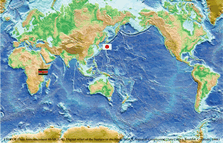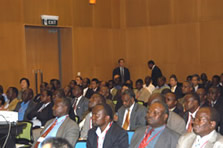The Kenya - Japan Exchange Seminar on Marine-Earth Science: Cooperating Towards a Better Planet Earth
2007/02/07

Japan's Subduction Zone and Kenya's Rifted Continental Margin

With over 140 Kenyan scientists present, the event was a great success.
There are two places on earth where the western margin of an ocean and the east coast of a continent intersect at equatorial latitudes. One is at the mouth of the Amazon, in South America. The other is the African coast from Somalia to Kenya. Their environments are, however, strikingly different. The Somalia-Kenya coast is conspicuously arid (savannah and desert), while rain forest and river delta environments dominate in the Amazon.
In Kenya, the interior, coastline (coral reef coast), and offshore environments are subject to the impact of the interactive effects of offshore rifting, a monsoon climate, and the Indian Ocean Dipole Mode phenomenon. That relatively simple environmental system is closely related to phenomena that occur on a global scale. The East African rift valley is, moreover, where the ancestors of homo sapiens evolved 3 million years ago.
Kenya and its offshore zone are thus extremely important places for understanding the relationships between our planet's plate tectonics, environmental change, and human evolution. At JAMSETC, our Frontier Research Center for Global Change and our Institute for Observational Research for Global Change play central roles in observations and research on the Indian Ocean and other areas to understand El Niño, the Asian Monsoon, and other phenomena impacting global climate change. To promote exchanges between Japan and Kenya, spurred by the deep sea drilling vessel Chikyu's shakedown drilling work offshore of Kenya, we carried out a seminar entitled “Kenya-Japan Exchange Seminar on Marine-Earth Science: Cooperating Towards a Better Planet Earth” on January 16, 2007, at the Japan Information and Culture Centre in the Embassy of Japan in Kenya.
In their remarks at the beginning of the seminar, Ambassador Miyamura of the Embassy of Japan in Kenya and Professor Mogoha, Vice-Chancellor of the University of Nairobi, mentioned that the event was the first such scientific exchange between Japan and Kenya and expressed their hopes that it would mark the start of ongoing exchanges. The lectures by Japanese and Kenyan scientists, each of great significance, both introduced research on marine-earth science and phenomena in the western Indian Ocean and East Africa and presented positive prospects for future cooperation.
During the seminar, the participants introduced oceanic research being conducted in Japan, research on global change, and the Chikyu deep-sea drilling vessel, and exchanged views on environmental change in Kenya and the Indian Ocean and on tectonic research. An important mission of this event was to discuss the possibilities for Kenyan-Japanese cooperation in these fields. The seminar itself, the field-specific discussions that occurred during it, and the exchanges between faculty of the University of Nairobi and the participating research institutions carried out that mission to the full. This successful event thus can lead the way to further cooperative exchanges, thanks to the generous assistance of the Japan Information and Culture Centre in the Embassy of Japan in Kenya, the University of Nairobi, the Kenya Marine and Fisheries Research Institute, and other organizations.
The Seminar Program
| Greetings | |||||
| |||||
| Indian Ocean Circulation and Climate Change in Kenya | |||||
 |
JAMSTEC and The Chikyu, Challenge for the Frontier of Marine and Earth Science and Technology Dr. Asahiko Taira (Executive Director, JAMSTEC) |
||||
| Indian Ocean Circulation and Climate Change in Kenya | |||||
 |
Climate Variability in the Tropical Indian Ocean and Its Impact on Climate in Kenya Dr. Yukio Masamoto (Frontier Research Center for Global Change, JAMSTEC, and Department of Earth and Planetary Science, University of Tokyo) |
||||
 |
Indian Ocean Dipole Index Recorded in Kenyan Coral Annual Band Dr. Hajime Kayane (Department of Earth and Planetary Science, University of Tokyo) |
||||
 |
Tropical Indian Ocean-Climate Interaction: Process modeling and global change scenarios. Professor N. J. Muthama (Department of Meteorology, University of Nairobi) |
||||
| Marine Ecosystem in the Indian Ocean (Kenya Coast) | |||||
 |
Impacts of global change on the Marine Ecosystem of the Western Indian Ocean. Professor M. J. Ntiba (School of Biological Sciences, University of Nairobi) |
||||
 |
Marine Research in Kenya Coast Dr. Edward Ndirui Kimani (Kenya Marine and Fisheries Research Institute) |
||||
 |
Marine Biological Studies in the Kenya's Coasts Professor Yoshihisa Shirayama (Seto Marine Biological Laboratory, Field Science Education and Research Center, Kyoto University) |
||||
| Geological Structure of Kenya | |||||
 |
The Conjugate East African and Madagascan Continental Margins, and the Western Somali Basin: Tectonics and Stratigraphy Professor Millard Coffin (Ocean Research Institute, University of Tokyo) |
||||
 |
Geological Structure of Kenya: Past global change and internal Earth processes. Professor E.M. Mathu (Department of Geology, University of Nairobi) Professor D.W. Ichang'i (Department of Geology, University of Nairobi) |
||||
| Closing remarks (Video presentation) | |||||
 |
Katsuyuki Kawai (Member of the House of Representatives and chair of the Japan-Kenya Parliamentary Friendship Committee) | ||||


